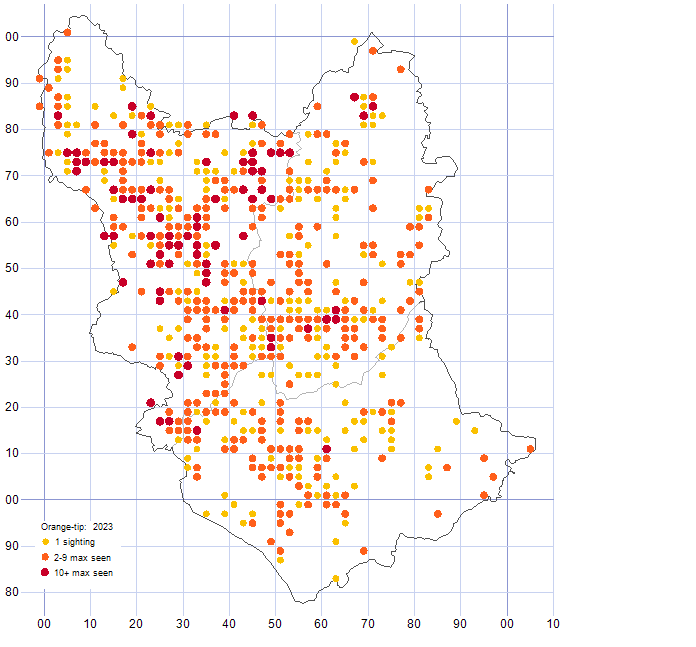
Orange-tip Anthocharis cardamines
Habitat
The Orange-tip is found in many habitats including hedgerows, along roadside verges, gardens, damp meadows and edges of woods.
Identification
Males are unmistakeable with the large orange tips to their forewings and can be easily identified, even in flight. Females, however, can be confused with Small and Green-veined Whites but the underwings of both male and female are very characteristic with their dappled green and white pattern.
Flight times
There is normally only one generation a year. Adults emerge in the third week of April, but can be earlier, and the flight period usually continues until mid-June.
Food plants
Eggs are laid singly on Cuckooflower, Garlic Mustard and other crucifers.

Distribution Maps
2005-2009

2010-14

2015-19

2015

| No of tetrads | 542 |
|---|---|
| First sighting | 04/04/2015 |
| Last sighting | 29/09/2015 |
2016

| No of tetrads | 570 |
|---|---|
| First sighting | 25/03/2016 |
| Last sighting | 29/08/2016 |
2017

| No of tetrads | 570 |
|---|---|
| First sighting | 01/04/2017 |
| Last sighting | 26/07/2017 |
2018

| No of tetrads | 530 |
|---|---|
| First sighting | 05/04/2018 |
| Last sighting | 21/07/2018 |
2019

| No of tetrads | 656 |
|---|---|
| First sighting | 24/03/2019 |
| Last sighting | 04/09/2019 |
2020

| No of tetrads | 583 |
|---|---|
| First sighting | 22/03/2020 |
| Last sighting | 24/08/2020 |
2021

| No of tetrads | 611 |
|---|---|
| First sighting | 04/03/2021 |
| Last sighting | 17/08/2021 |
2022

| No of tetrads | 501 |
|---|---|
| First sighting | 07/03/2022 |
| Last sighting | 05/08/2022 |
2023

| No of tetrads | 576 |
|---|---|
| First sighting | 25/03/2023 |
| Last sighting | 08/07/2023 |
Photo Gallery
Similar or Easily Confused Species and ID Hints
The male Orange-tip is unmistakable with its bright orange wing tips and patrolling flight, along paths and woodland edges. The female, however, can be difficult to distinguish from either the Small White or Green-veined White whilst in flight. Whilst at rest the patterning on the rear underwing is distinctive and cryptic.
Green-veined White Pieris napi
Green-veined White are usually found in similar habitats but the underwing patterning is less intense and the upper wing tip markings are paler and not as extensive.
Small White Pieris rapae
Small White are usually smaller and have paler and less extensive wing-tips than the female Orange-tip. The underside of the rear wing is a plain yellow.





